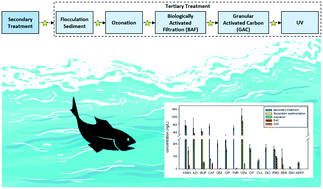当前位置:
X-MOL 学术
›
Environ. Sci.: Water Res. Technol.
›
论文详情
Our official English website, www.x-mol.net, welcomes your feedback! (Note: you will need to create a separate account there.)
Assessing pharmaceutical removal and reduction in toxicity provided by advanced wastewater treatment systems†
Environmental Science: Water Research & Technology ( IF 5 ) Pub Date : 2019-11-04 , DOI: 10.1039/c9ew00559e Luisa F. Angeles 1, 2, 3, 4, 5 , Rachel A. Mullen 1, 2, 3, 4, 5 , Irvin J. Huang 5, 6, 7, 8 , Christopher Wilson 5, 9, 10 , Wendell Khunjar 5, 11, 12 , Howard I. Sirotkin 5, 7, 8, 13 , Anne E. McElroy 5, 6, 7, 8 , Diana S. Aga 1, 2, 3, 4, 5
Environmental Science: Water Research & Technology ( IF 5 ) Pub Date : 2019-11-04 , DOI: 10.1039/c9ew00559e Luisa F. Angeles 1, 2, 3, 4, 5 , Rachel A. Mullen 1, 2, 3, 4, 5 , Irvin J. Huang 5, 6, 7, 8 , Christopher Wilson 5, 9, 10 , Wendell Khunjar 5, 11, 12 , Howard I. Sirotkin 5, 7, 8, 13 , Anne E. McElroy 5, 6, 7, 8 , Diana S. Aga 1, 2, 3, 4, 5
Affiliation

|
Wastewater treatment plants (WWTPs) have been considered as hotspots for pharmaceutical residues, such as antidepressants, antimicrobials and active ingredients of over-the-counter drugs. Despite evidence of ecotoxicological effects of these microcontaminants on exposed fish in the aquatic systems, there is currently no regulation in terms of the levels of pharmaceutical residues allowable for release into the environment. Depending on the extent of treatment employed in WWTPs removal of pharmaceutical residues are highly variable. This study compares the removal efficiencies for several antimicrobials, antidepressants, and other pharmaceuticals at different stages of the wastewater treatment process of seven WWTPs that employ varying treatment technologies including biological, physical, advanced chemical oxidation, and a combination of two or more of these technologies. The concentrations of the pharmaceuticals were measured by liquid chromatography/mass spectrometry at multiple points during the course of treatment. Additionally, the ecotoxicological effects of the WWTP effluents were also evaluated based on the behavioral effects in larval zebrafish. It was found that biological treatment process provided negative to low removal (<50%), while activated carbon and ozonation provided high removal (>95% overall removal) for 14 out of 15, and 9 out of 11 compounds detected in WWTP influents, respectively. Notably, the final effluents of the seven WWTPs in this study did not show any significant behavioral alterations in zebrafish, indicating that despite differences in removal efficiencies all the treatment processes investigated are sufficient in preventing short-term biological effects.
中文翻译:

评估先进废水处理系统可提供的药物去除和毒性降低功能†
废水处理厂(WWTP)被认为是药物残留的热点,例如抗抑郁药,抗微生物药和非处方药的活性成分。尽管有证据表明这些微污染物对水生系统中裸露的鱼类具有生态毒理作用,但目前尚无关于允许释放到环境中的药物残留量的规定。根据污水处理厂采用的处理程度,药物残留的去除是高度可变的。这项研究比较了七个污水处理厂污水处理过程不同阶段中几种抗菌剂,抗抑郁药和其他药物的去除效率,这些污水处理厂采用了不同的处理技术,包括生物,物理,高级化学氧化,以及这些技术中的两种或多种的组合。在治疗过程中,通过液相色谱/质谱法在多个点测量药物的浓度。此外,还根据幼虫斑马鱼的行为影响评估了污水处理厂废水的生态毒理作用。研究发现,生物处理过程对去除率低至(50%)呈负相关,而活性炭和臭氧化处理对WWTP进水中检测到的15种化合物中有14种和11种化合物中有9种具有高去除率(总去除率> 95%),分别。值得注意的是,这项研究中的七个污水处理厂的最终废水在斑马鱼中并未显示出任何明显的行为改变,
更新日期:2019-12-19
中文翻译:

评估先进废水处理系统可提供的药物去除和毒性降低功能†
废水处理厂(WWTP)被认为是药物残留的热点,例如抗抑郁药,抗微生物药和非处方药的活性成分。尽管有证据表明这些微污染物对水生系统中裸露的鱼类具有生态毒理作用,但目前尚无关于允许释放到环境中的药物残留量的规定。根据污水处理厂采用的处理程度,药物残留的去除是高度可变的。这项研究比较了七个污水处理厂污水处理过程不同阶段中几种抗菌剂,抗抑郁药和其他药物的去除效率,这些污水处理厂采用了不同的处理技术,包括生物,物理,高级化学氧化,以及这些技术中的两种或多种的组合。在治疗过程中,通过液相色谱/质谱法在多个点测量药物的浓度。此外,还根据幼虫斑马鱼的行为影响评估了污水处理厂废水的生态毒理作用。研究发现,生物处理过程对去除率低至(50%)呈负相关,而活性炭和臭氧化处理对WWTP进水中检测到的15种化合物中有14种和11种化合物中有9种具有高去除率(总去除率> 95%),分别。值得注意的是,这项研究中的七个污水处理厂的最终废水在斑马鱼中并未显示出任何明显的行为改变,



























 京公网安备 11010802027423号
京公网安备 11010802027423号